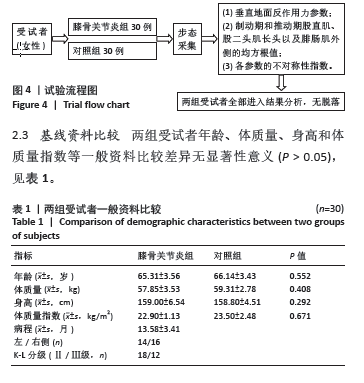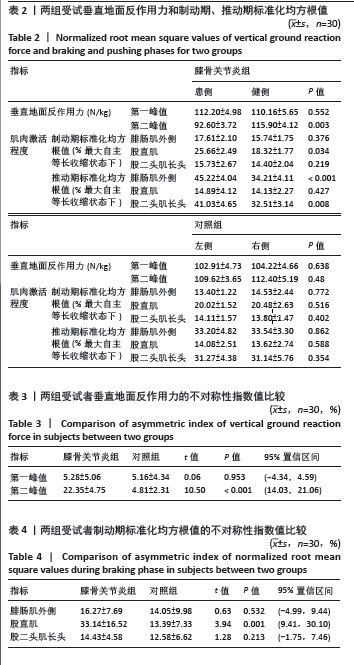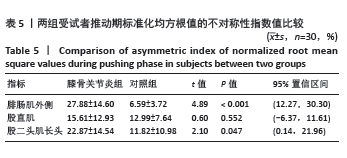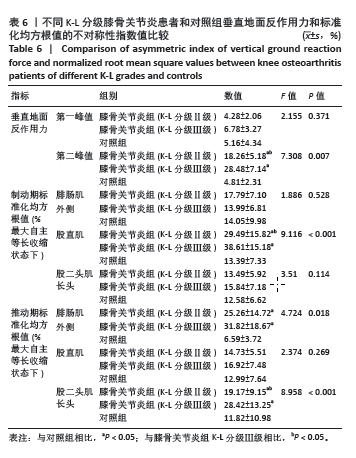[1] 中华医学会物理医学与康复学分会, 四川大学华西医院. 中国膝骨关节炎康复治疗指南(2023版)[J]. 中国循证医学杂志,2024,24(1): 1-14.
[2] ÖZüDOğRU A, GELECEK N. Effects of closed and open kinetic chain exercises on pain, muscle strength, function, and quality of life in patients with knee osteoarthritis. Rev Assoc Med Bras. 2023;69(7): e20230164.
[3] DE ROOIJ M, VAN DER LEEDEN M, HEYMANS MW, et al. Prognosis of Pain and Physical Functioning in Patients With Knee Osteoarthritis: A Systematic Review and Meta-Analysis. Arthritis Care Res (Hoboken). 2016;68(4):481-492.
[4] 冯晓晴, 蔡道章, 余星磊,等. 基于GBD大数据中国膝骨关节炎疾病负担现状与趋势分析[J]. 现代预防医学,2022,49(10):1753-1760.
[5] BLACK AL, CLARK AL. Sexual dimorphism in knee osteoarthritis: Biomechanical variances and biological influences. J Orthop. 2022;32: 104-108.
[6] LIU S, AMIRI P, MCGREGOR AH, et al. Bilateral Asymmetry in Knee and Hip Musculoskeletal Loading During Stair Ascending/Descending in Individuals with Unilateral Mild-to-Moderate Medial Knee Osteoarthritis. Ann Biomed Eng. 2023;51(11):2490-2503.
[7] SAXBY DJ, BRYANT AL, VAN GINCKEL A, et al. Greater magnitude tibiofemoral contact forces are associated with reduced prevalence of osteochondral pathologies 2-3 years following anterior cruciate ligament reconstruction. Knee Surg Sports Traumatol Arthrosc. 2019; 27(3):707-715.
[8] SHIMIZU H, SHIMOURA K, IIJIMA H, et al. Functional manifestations of early knee osteoarthritis: a systematic review and meta-analysis. Clin Rheumatol. 2022;41(9):2625-2634.
[9] MILLS K, HUNT MA, FERBER R. Biomechanical deviations during level walking associated with knee osteoarthritis: a systematic review and meta-analysis. Arthritis Care Res (Hoboken). 2013;65(10):1643-1665.
[10] MILLS K, HUNT MA, LEIGH R, et al. A systematic review and meta-analysis of lower limb neuromuscular alterations associated with knee osteoarthritis during level walking. Clin Biomech (Bristol, Avon). 2013;28(7):713-724.
[11] TAJDINI H, LETAFATKAR A, BREWER BW, et al. Association between Kinesiophobia and Gait Asymmetry after ACL Reconstruction: Implications for Prevention of Reinjury. Int J Environ Res Public Health. 2021;18(6):3264.
[12] 刘鑫玥, 刘鹏波, 霍洪峰. 双任务介入对社区脑卒中患者步态参数及其对称性的影响[J]. 医用生物力学,2023,38(6):1114-1119.
[13] GIANNAKOU E, FOTIADOU S, GOURGOULIS V, et al. A Comparative Analysis of Symmetry Indices for Spatiotemporal Gait Features in Early Parkinson’s Disease. Neurol Int. 2023;15(3):1129-1139.
[14] MANTASHLOO Z, LETAFATKAR A, MORADI M. Vertical ground reaction force and knee muscle activation asymmetries in patients with ACL reconstruction compared to healthy individuals. Knee Surg Sports Traumatol Arthrosc. 2020;28(6):2009-2014.
[15] 中华中医药学会. 膝骨关节炎中西医结合诊疗指南(2023年版)[J]. 中医正骨,2023,35(6):1-10.
[16] YU HB, TAI WH, LI J, et al. Effects of Shoe Midsole Hardness on Lower Extremity Biomechanics during Jump Rope in Healthy Males. Healthcare (Basel). 2021;9(10):1394.
[17] 张嘉源, 马小远, 周志鹏,等. 非预期条件下前交叉韧带重建术后运动员侧切动作下肢运动生物力学特征[J]. 医用生物力学,2023, 38(6):1127-1133.
[18] KONDO M, IWAMOTO Y, KITO N. Relationship between forward propulsion and foot motion during gait in healthy young adults. J Biomech. 2021;121:110431.
[19] 刘鑫玥, 霍洪峰. 不同类型和负荷双任务对健康人动态姿势控制的影响[J]. 医用生物力学,2023,38(4):791-796+843.
[20] GIRARD O, MILLET GP, MICALLEF JP. Constant low-to-moderate mechanical asymmetries during 800-m track running. Front Sports Act Living. 2024;6:1278454.
[21] 卢泽惠. 单侧负重状态下行走的生物力学特征分析[D]. 呼和浩特:内蒙古师范大学,2022.
[22] WIIK AV, AQIL A, BREVADT M, et al. Abnormal ground reaction forces lead to a general decline in gait speed in knee osteoarthritis patients. World J Orthop. 2017;8(4):322-328.
[23] HODT-BILLINGTON C, HELBOSTAD JL, VERVAAT W, et al. Criteria of gait asymmetry in patients with hip osteoarthritis. Physiother Theory Pract. 2012;28(2):134-141.
[24] BALASUBRAMANIAN CK, BOWDEN MG, NEPTUNE RR, et al. Relationship between step length asymmetry and walking performance in subjects with chronic hemiparesis. Arch Phys Med Rehabil. 2007;88(1):43-49.
[25] 傅升星, 侯美金, 李镇辉,等. 电针对膝骨性关节炎患者登梯垂直地面反作用力及冲量对称性的影响[J]. 医用生物力学,2020,35(4): 467-473.
[26] 安丙辰, 郑洁皎, 沈利岩. 膝骨关节炎与膝关节伸、屈肌群肌力的相关性研究[J]. 医用生物力学,2015,30(2):174-178.
[27] ALSHAHRANI MS, REDDY RS, TEDLA JS, et al. Association between Kinesiophobia and Knee Pain Intensity, Joint Position Sense, and Functional Performance in Individuals with Bilateral Knee Osteoarthritis. Healthcare (Basel). 2022;10(1):120.
[28] 陈博, 王芗斌, 熊凤,等. 膝骨关节炎患者登梯活动中下肢肌群肌电特征的研究进展[J]. 风湿病与关节炎,2019,8(6):68-71.
[29] HUBLEY-KOZEY CL, HATFIELD GL, ASTEPHEN WILSON JL, et al. Alterations in neuromuscular patterns between pre and one-year post-total knee arthroplasty. Clin Biomech (Bristol, Avon). 2010;25(10): 995-1002.
[30] SANCHEZ-RAMIREZ DC, MALFAIT B, BAERT I, et al. Biomechanical and neuromuscular adaptations during the landing phase of a stepping-down task in patients with early or established knee osteoarthritis. Knee. 2016;23(3):367-375.
[31] 李捷婷, 陈耿钊, 方倩颖,等. 基于多通道表面肌电探讨不同角速度下膝骨关节炎患者生物力学基础的研究[J]. 中国康复医学杂志, 2024,39(2):218-225.
[32] HURWITZ DE, RYALS AB, CASE JP, et al. The knee adduction moment during gait in subjects with knee osteoarthritis is more closely correlated with static alignment than radiographic disease severity, toe out angle and pain. J Orthop Res. 2002;20(1):101-107. |



